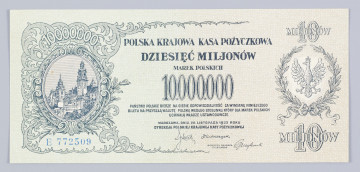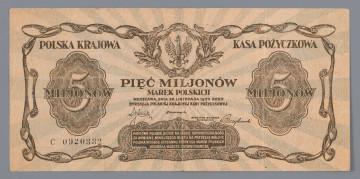
Cheque for 100,000,000 Polish marks - a template
1923
National Museum in Lublin
Part of the collection: Paper money during the Second Polish Republic
The regaining of independence by Poland after 123 years of captivity posed extremely difficult tasks for the leaders of the Republic. Apart from the most important one, which consisted in defending the newly regained possibility of self-determination, an extremely difficult task was to create an efficiently functioning economy based on the existing resources. The introduction of a new monetary system therefore became one of the most important issues. It was realized that the mark system inherited from the war period was transitory in nature. Therefore, work on the creation of an indigenous monetary system began very quickly. Apart from strictly economic activities, this also included design work on the appearance of the new money. By the resolution of the Sejm of 28 February 1919, the new currency was named złoty. In the case of banknotes, due to the difficult internal situation, foreign institutions were entrusted with the task of printing new money for the reborn country. The denominations from 1 to 50 zlotys were designed and printed in the printing house of the French Bank.
The obverse of the two złoty banknote, like almost all other denominations of the issue, featured the image of Tadeusz Kościuszko. The design was not very impressive - apart from the aforementioned image of the leader of the uprising of 1794, it was limited to an ornamental drawing. As in the case of other designs, the banknote was clearly marked, indicating its non-circular character. These were two diagonal red lines, between which the word “SPECIMEN” and the inscription “No value” were placed in the upper left and lower right corners of both the obverse and the reverse. Additionally, some of the banknotes had perforations in the form of two holes with a diameter of about 10 mm. In the case of the presented specimen these holes had very frayed edges. The specimens had series and number marking, but these were not printed but imprinted by hand using a numbering machine.
Paper two-zloty bills never entered circulation as banknotes. After being printed, they were stored in crates for five years to become a means of payment only on 28 April 1924. At that time, they were briefly in the hands of the inhabitants of Poland - together with paper one-zloty bills – as treasury notes, replacing coins.
Leszek Poniewozik
Author / creator
Dimensions
cały obiekt: height: 116 mm, width: 81 mm
Object type
paper money
Technique
Material
paper
Creation time / dating
Creation / finding place
Owner
The National Museum in Lublin
Identification number
Location / status

1923
National Museum in Lublin

1923
National Museum in Lublin

1923
National Museum in Lublin
DISCOVER this TOPIC
Castle Museum in Łańcut
DISCOVER this PATH
Educational path